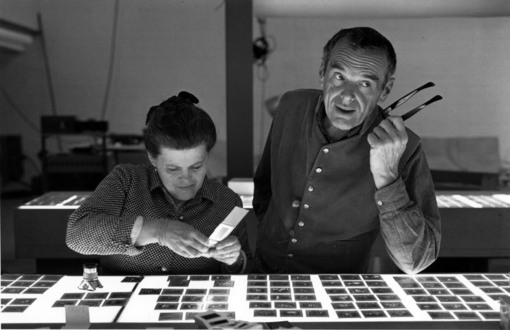“Charles & Ray Eames: The Architect and the Painter” (85 minutes) premieres December 19th at 10:00pm on the PBS series “American Masters, ” and will be available thereafter on PBS-on-demand. The film will also be released on DVD on Dec. 13th.
The six-DVD set of “The Films of Charles & Ray Eames” is available from Facets Multimedia ($79.99) and a few other online outlets, and each disc can be rented separately from Netflix.
If I had been a precocious six-year-old with a passion for architecture, I could’ve told you that my elementary school was an Eames building. It wasn’t designed by Charles Eames himself, but everything about it was influenced by the design aesthetic of Charles and Ray Eames, most notably the design of the Eames’ own home in Pacific Palisades, California.

A now-legendary structure known in the architecture world as Case Study No. 8, the Eames House (completed in 1949) is a geometrical marvel of steel and glass, squares and rectangles carefully aligned or offset to pleasing effect, with bold colors (Ray being the painter and co-designer, Charles being the architect) to complement the inviting lines of the structure. Like so many public structures built in the late ’50s and early ’60s, Seaview Elementary in Edmonds, Washington, was a wanna-be Eames House for grade-schoolers, a modest, functional tribute to Charles and Ray Eames and a symbol of their phenomenal influence on the look of the 20th century.


So ubiquitous is the Eames influence that it remains utterly unique, not merely in terms of design but in the grand design of the human species. Stroll through any major city in the world and chances are you’ll see the Eames influence everywhere, from the cheap functionality of IKEA furniture to the form-fitting fiberglass of chairs in cafeterias, lobbies and waiting rooms all over the planet. When you realize that the Eames influence is literally inescapable in the lives of city-dwellers everywhere, you don’t feel resentful as you might upon finding Starbucks coffee shops on both sides of the same street. Instead, you might register a kind of awestruck gratitude for how Eames designs have improved your life and the lives of everyone you know.
And of course, it all began with a chair.

Co-produced and co-directed by seasoned PBS producers Jason Cohn and Bill Jersey, “Charles & Ray Eames: The Architect and the Painter” is an inspiring and invigorating presentation of PBS’s “American Masters. ” Narrated (a bit too emphatically) by actor James Franco, it gets right down to business with the post-World War II creation of the Eames chair, cited by Time magazine as “the greatest design of the 20th century. ” And who can argue with that? Introduced in 1946 and molded (after much trial and error) from contoured layers of form-fitting plywood, the classic Eames chair was followed by countless iterations and epitomized the egalitarian slogan from which all of the Eames’ affordable, mass-produced designs flowed: “The best to the most for the least.”

They were more than just a married couple who were dynamic collaborators (not brothers, as many wrongly assumed). In many respects, Charles and Ray were two sides of the same artistic coin: Taken separately, both possessed prodigious talent, but when you combined his visionary architecture with her painterly sensibility, you got something akin to the later collaboration between Keith Richards and Mick Jagger: Without Charles (1907-1978) and Ray (1912-1988), there is no Eames design; without the Glimmer Twins, you can’t get no satis… er, Rolling Stones.

Aside from a few design flourishes of its own (the opening credits are inspired by the interlocking photo-cards that the Eameses created), “The Architect and the Painter” follows the basic “American Masters” template (and marks the end of the series’ 25th season) with straightforward chronology and talking-head interviews. Several of the interviewees were designers in the legendary Eames office at 901 Washington Boulevard in Venice, California, and it’s a tribute to the Eames’ recruiting skills (and judgment of character) that all of these co-designers are themselves unique, eloquent, and fascinating people, bursting with insight and superlatives related to their time spent with the Eameses.

By all accounts, “901” was an amazing workplace, dazzling employees and visitors alike with its magical atmosphere (like “working in Disneyland, ” says former Eames designer Tina Beebe). When the Eames chair was mass-produced and triumphantly marketed by the Herman Miller furniture company, the subsequent flood of sales royalties allowed the Eamses to begin creating the whimsical films and other projects that cemented 901’s reputation as “the most creative place in the world.”

Another visitor who “fell in love” with the Eames office was UCLA film-school graduate and Los Angeles Free Press film critic Paul Schrader, long before he wrote “Taxi Driver” and embarked on his own distinguished directorial career. Schrader was perhaps the first critic to write about the Eames’ prodigious output on film, and used his critic job as an excuse to visit “901.” Like everyone who visited the Eamses (including Buckminster Fuller and Billy Wilder, seen at the Eames House in rare archival footage), Schrader recognized 901 as a place where all aspects of creativity were indulged and encouraged, and where any hint of conventional structure (like regular hours and staff meetings) was steadfastly avoided.

The lounge chair and ottoman above were designed for Billy Wilder.

Eames designers like Gordon Ashby, the late Jon Neuhart (giving his final interview here) and Jeannine Oppewall (now one of Hollywood’s top production designers) recall their Eames experience in glowing terms, but “The Architect and the Painter” doesn’t attempt to whitewash the more difficult aspects of working with the Eamses — or rather, working with Charles. “The matter of credit” was a sore spot among some designers, who remained anonymous despite having made substantial contributions with little or no input from Charles Eames. (That one-name dominance is nothing new in the art world: Warhol never credited his assistants, and here in Seattle, glass artist Dale Chihuly runs a brand-name studio filled with anonymous artisans.)

Even though Ray was Charles’ equal in their collaboration (“Anything I can do,” Charles once said, “she can do better”), we see how her subordinate role — and Charles’ later infidelity — took an emotional toll on Ray, who valued her marriage too much to walk away from it. (In a dignified interview, Charles’ former mistress and art historian, Judith Wechsler, reveals that she reluctantly ended their passionate affair out of friendship and respect for Ray.)
One of the film’s most revealing archival clips comes from a 1957 broadcast of “The Arlene Francis Show,” in which the sexual politics of the Eisenhower era are fully in play: As she invites the Eameses to demonstrate how the Eames chair was created, the thoroughly domesticated Francis insists on casting Ray as a subordinate wife-servant, literally and figuratively placing Ray “behind her man.” It’s an embarrassing time-capsule moment and it’s only fitting that Ray’s place in the partnership was more fully recognized when the feminist movement gained momentum in the ’70s.
And yet Charles is not judged too harshly: Seemingly everyone who met him, male or female, found him charismatic, and with his broad smile and childlike sense of fun, he didn’t have a malicious bone in his body. Remarkably, every Eames project was completed on a handshake, and Eames paid for any budget overages out of his own pocket. Watching the film, it’s impossible to dislike the guy.
<iframe width="510" height="376" src="http://www.youtube.com/embed/0fKBhvDjuy0?rel=0" frameborder="0" allowfullscreen="“>

As “The Architect and the Painter” proceeds to chronicle the Eames’ ever-growing projects for corporate giants like IBM (for whom Charles made his best-known film, the pioneering “cosmic zoom” exercise titled “Powers of Ten”), the documentary emerges as a four-decade chronicle of extraordinary love and symbiosis expressed through extraordinary creativity. Consider the fact that Ray Eames, on her deathbed in 1988, literally willed herself to stay alive until the 10th anniversary of Charles’ passing. It was her way of honoring and ensuring their eternal connectedness in life and art.
Twenty-three years later, we can still witness that connectedness nearly everywhere we look. Charles and Ray Eames defined the look of the second half of the 20th century, and their designs continue to shape the 21st century we live in today.


Watch Charles & Ray Eames: The Architect and the Painter on PBS. See more from AMERICAN MASTERS.
Watch Eames Outtakes: Pilgrimage on PBS. See more from AMERICAN MASTERS.
Watch Eames Outtakes: Charles’ Uniform on PBS. See more from AMERICAN MASTERS.
Page designed by Jim Emerson

A Seattle-based freelancer, Jeff Shannon has been writing about film and filmmakers since 1985, for the Seattle Post-Intelligencer (1985-92) and The Seattle Times (1992-present). He was the assistant editor of Microsoft’s “Cinemania” CD-ROM and website (1992-98), where he worked with rogerebert.com editor Jim Emerson, and was an original member of the DVD & Video editorial staff at Amazon.com (1998-2001). Disabled by a spinal cord injury since 1979 (C-5/6 quadriplegia), he occasionally contributes disability-related articles to New Mobility magazine, and is presently serving his second term on the Washington State Governor’s Committee on Disability Issues and Employment.












